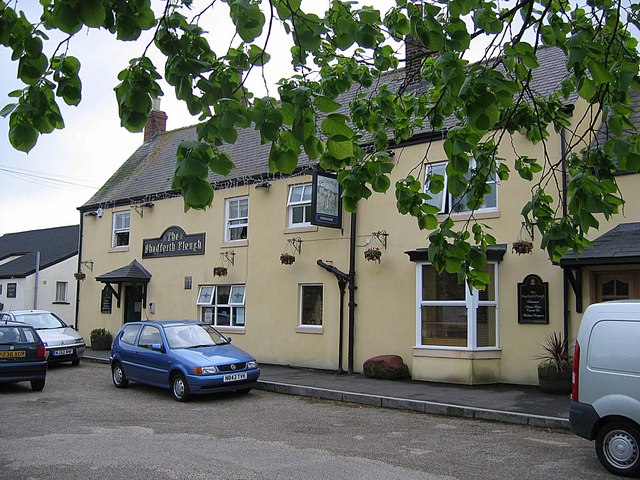|
Sherburn Hospital
Sherburn Hospital (also known as Christ's Hospital in Sherburn) is a medieval hospital located in the hamlet of Sherburn House to the southeast of Durham, England. History The hospital was founded in 1181 by Hugh de Puiset (Bishop Pudsey), to care for 65 lepers and dedicated to "our Lord, to the Blessed Virgin, to St. Lazarus and his sisters, Mary and Martha". Its statutes were amended at the request of Bishops Richard Kellaw and Thomas Langley. The hospital was endowed with a range of lands, including Sherburn, Garmondsway Moor, Ebchester, Whitton, Raceby and Sheraton. Sherburn Hospital survived the Dissolution of the Monasteries and the associated closures of many hospitals (including nearby Kepier) and a new constitution was introduced by Act of Parliament in 1585 for the establishment of "The Master and Brethren of Christ's Hospital in Sherborne near Durham". Ralph Lever, canon of Durham Cathedral, was master of the hospital at the time of his death. George Stanley Fabe ... [...More Info...] [...Related Items...] OR: [Wikipedia] [Google] [Baidu] |
Sherburn House
Sherburn House is a hamlet in County Durham, England. It is situated approximately south-east of Durham between Sherburn and Shincliffe Village. It is in the civil parish of Shincliffe. Sherburn House is the location of Sherburn Hospital Sherburn Hospital (also known as Christ's Hospital in Sherburn) is a medieval hospital located in the hamlet of Sherburn House to the southeast of Durham, England. History The hospital was founded in 1181 by Hugh de Puiset (Bishop Pudsey), to .... External links Subterranea Britannica entry on Sherburn House station Villages in County Durham {{Durham-geo-stub ... [...More Info...] [...Related Items...] OR: [Wikipedia] [Google] [Baidu] |
Durham Cathedral
The Cathedral Church of Christ, Blessed Mary the Virgin and St Cuthbert of Durham, commonly known as Durham Cathedral and home of the Shrine of St Cuthbert, is a cathedral in the city of Durham, County Durham, England. It is the seat of the Bishop of Durham, the fourth-ranked bishop in the Church of England hierarchy. Building of the present Norman-era cathedral started in 1093, replacing the city's previous 'White Church'. In 1986 the cathedral and Durham Castle were designated a UNESCO World Heritage Site. Durham Cathedral's relics include: Saint Cuthbert's, transported to Durham by Lindisfarne monks in the 800s; Saint Oswald's head and the Venerable Bede's remains. The Durham Dean and Chapter Library contains: sets of early printed books, some of the most complete in England; the pre-Dissolution monastic accounts and three copies of '' Magna Carta''. From 1080 until 1836, the Bishop of Durham held the powers of an Earl Palatine. In order to protect the Anglo-S ... [...More Info...] [...Related Items...] OR: [Wikipedia] [Google] [Baidu] |
English Medieval Hospitals And Almshouses
English usually refers to: * English language * English people English may also refer to: Peoples, culture, and language * ''English'', an adjective for something of, from, or related to England ** English national identity, an identity and common culture ** English language in England, a variant of the English language spoken in England * English languages (other) * English studies, the study of English language and literature * ''English'', an Amish term for non-Amish, regardless of ethnicity Individuals * English (surname), a list of notable people with the surname ''English'' * People with the given name ** English McConnell (1882–1928), Irish footballer ** English Fisher (1928–2011), American boxing coach ** English Gardner (b. 1992), American track and field sprinter Places United States * English, Indiana, a town * English, Kentucky, an unincorporated community * English, Brazoria County, Texas, an unincorporated community * Engli ... [...More Info...] [...Related Items...] OR: [Wikipedia] [Google] [Baidu] |
Grade II* Listed Buildings In County Durham
There are over 20,000 Grade II* listed buildings in England. This page is a list of these buildings in the county of Durham, sub-divided by unitary authority. County Durham Darlington Hartlepool Stockton-on-Tees The Borough crosses county Durham and North Yorkshire, Stockton-on-Tees town is in county Durham therefore buildings are listed here: Notes See also *Grade I listed buildings in County Durham * :Grade II* listed buildings in County Durham References National Heritage List for EnglandKeys To The PastDurham/Northumbria councils site External links {{DEFAULTSORT:List Of Grade II listed buildings in Durham Durham Durham most commonly refers to: *Durham, England, a cathedral city and the county town of County ... [...More Info...] [...Related Items...] OR: [Wikipedia] [Google] [Baidu] |
Grade II Listed Buildings In County Durham
Grade most commonly refers to: * Grade (education), a measurement of a student's performance * Grade, the number of the year a student has reached in a given educational stage * Grade (slope), the steepness of a slope Grade or grading may also refer to: Music * Grade (music), a formally assessed level of profiency in a musical instrument * Grade (band), punk rock band * Grades (producer), British electronic dance music producer and DJ Science and technology Biology and medicine * Grading (tumors), a measure of the aggressiveness of a tumor in medicine * The Grading of Recommendations Assessment, Development and Evaluation (GRADE) approach * Evolutionary grade, a paraphyletic group of organisms Geology * Graded bedding, a description of the variation in grain size through a bed in a sedimentary rock * Metamorphic grade, an indicatation of the degree of metamorphism of rocks * Ore grade, a measure that describes the concentration of a valuable natural material in the surroun ... [...More Info...] [...Related Items...] OR: [Wikipedia] [Google] [Baidu] |
Hospitals In County Durham
A hospital is a health care institution providing patient treatment with specialized health science and auxiliary healthcare staff and medical equipment. The best-known type of hospital is the general hospital, which typically has an emergency department to treat urgent health problems ranging from fire and accident victims to a sudden illness. A district hospital typically is the major health care facility in its region, with many beds for intensive care and additional beds for patients who need long-term care. Specialized hospitals include trauma centers, rehabilitation hospitals, children's hospitals, seniors' (geriatric) hospitals, and hospitals for dealing with specific medical needs such as psychiatric treatment (see psychiatric hospital) and certain disease categories. Specialized hospitals can help reduce health care costs compared to general hospitals. Hospitals are classified as general, specialty, or government depending on the sources of income received. A teaching ... [...More Info...] [...Related Items...] OR: [Wikipedia] [Google] [Baidu] |
Hospitals Established In The 12th Century
A hospital is a health care institution providing patient treatment with specialized health science and auxiliary healthcare staff and medical equipment. The best-known type of hospital is the general hospital, which typically has an emergency department to treat urgent health problems ranging from fire and accident victims to a sudden illness. A district hospital typically is the major health care facility in its region, with many beds for intensive care and additional beds for patients who need long-term care. Specialized hospitals include trauma centers, rehabilitation hospitals, children's hospitals, seniors' (geriatric) hospitals, and hospitals for dealing with specific medical needs such as psychiatric treatment (see psychiatric hospital) and certain disease categories. Specialized hospitals can help reduce health care costs compared to general hospitals. Hospitals are classified as general, specialty, or government depending on the sources of income received. A teaching ... [...More Info...] [...Related Items...] OR: [Wikipedia] [Google] [Baidu] |
1181 Establishments In England
Year 1181 ( MCLXXXI) was a common year starting on Thursday (link will display the full calendar) of the Julian calendar. Events By place Europe * King Philip II (Augustus) annuls all loans made by Jews to Christians, and takes a percentage for himself. A year later, he confiscates all Jewish property and expels the Jews from Paris. * Philip II begins a war against Philip of Alsace, count of Flanders, over the Vermandois. He claims the territory for his wife Isabella of Hainault as her dowry. Philip is unwilling to give it up. * Henry the Lion, duke of Saxony, submits to Emperor Frederick I (Barbarossa) at an Imperial Diet in Erfurt. He is banished to England and retains only Brunswick among his former lands. * King Béla III of Hungary and Croatia goes to war with Venice in an effort to recover Dalmatia. The city of Zadar (located on the Adriatic Sea) accepts Béla's suzerainty. * After a series of defeats, the Almohad fleet under the admiral Ahmad al-Siqilli, crushe ... [...More Info...] [...Related Items...] OR: [Wikipedia] [Google] [Baidu] |
Anthony Salveyn
Anthony Salveyn (aka Anthony Salvin ''A History of the County of Oxford: Volume 3: The University of Oxford'', 1954, pp. 61–81.) was a of , , .Carr, William, [...More Info...] [...Related Items...] OR: [Wikipedia] [Google] [Baidu] |
Listed Buildings
In the United Kingdom, a listed building or listed structure is one that has been placed on one of the four statutory lists maintained by Historic England in England, Historic Environment Scotland in Scotland, in Wales, and the Northern Ireland Environment Agency in Northern Ireland. The term has also been used in the Republic of Ireland, where buildings are protected under the Planning and Development Act 2000. The statutory term in Ireland is " protected structure". A listed building may not be demolished, extended, or altered without special permission from the local planning authority, which typically consults the relevant central government agency, particularly for significant alterations to the more notable listed buildings. In England and Wales, a national amenity society must be notified of any work to a listed building which involves any element of demolition. Exemption from secular listed building control is provided for some buildings in current use for worship, ... [...More Info...] [...Related Items...] OR: [Wikipedia] [Google] [Baidu] |
Shincliffe
Shincliffe is a village and civil parish in County Durham, England. The parish population (according to the 2011 census) was 1,796. It is situated just over to the south-east of Durham city centre, on the A177 road to Stockton. Shincliffe is also a civil and ecclesiastical parish consisting of Shincliffe Village, High Shincliffe, Sherburn House and Whitwell House. Shincliffe is regarded as one of the most affluent villages in Durham City and has been designated a conservation area to preserve its historic character. History The place-name 'Shincliffe' is first attested in the ''Liber Vitae Ecclesiae Dunelmensis'' of circa 1085, where it appears as ''Scinneclif''. It appears in the Charter Rolls of 1195 as ''Sineclive''. The name means 'the cliff of the spectre or demon, haunted cliff'. Shincliffe is the site of a mediaeval bridge over the River Wear and archaeological investigations in 2005 suggest Shincliffe may have been the site of a Roman crossing. In the Middle Age ... [...More Info...] [...Related Items...] OR: [Wikipedia] [Google] [Baidu] |
Shadforth
Shadforth is a village in County Durham, England. It is situated a few miles to the east of Durham. The historic centre of the village is designated a conservation area. The population of the civil parish taken at the 2011 census was 2118. Shadforth is also a civil parish that also incorporates Ludworth and Sherburn Hill. History Shadforth was a farming village from around AD 600. The village is mentioned in the Boldon Book The Boldon Book (also known as the Boldon Buke) contains the results of a survey of the bishopric of Durham that was completed on the orders of Hugh du Puiset, Bishop of Durham, in 1183, designed to assist the administration of the vast diocesan e ... of 1183. It is perhaps the only village in England with the name 'Shadforth' meaning 'Shallow Ford’. Shadforth is unusual in that it has never had its own pit in an area where mining was a large part of the community. References External links Shadforth Plough Pub & Restaurant Villages in Coun ... [...More Info...] [...Related Items...] OR: [Wikipedia] [Google] [Baidu] |




